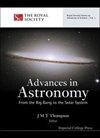Study of Chang’E-2 Microwave Radiometer Data in the Lunar Polar Region
IF 1.2
4区 物理与天体物理
Q3 ASTRONOMY & ASTROPHYSICS
引用次数: 10
Abstract
The Chang’E-2 (CE-2) four-channel microwave radiometer (MRM) data with frequencies of 3 GHz, 7.8 GHz, 19.35 GHz, and 37 GHz have been used to investigate the properties of lunar surface such as regolith thickness, dielectric constant, and titanium abundance within a depth of several meters in middle and low latitudes. The purpose of this work is to take a close look at MRM data in the polar regions of the Moon and analyze the characteristics of the brightness temperature (TB) in permanently shadowed regions (PSRs), especially where evidence of water ice has been found. First, the comparisons of brightness temperature values in the polar region and in low latitudes show that (1) the periodic diurnal (day/night) variation of TB becomes weak in high latitudes since topography plays a dominant role in determining TB in polar region and (2) seasonal effects are more recognizable in polar region than in low latitudes due to the weak illumination condition. Second, even without direct sun illumination, significant seasonal variations of TBs are observed in PSRs, probably caused by the scattering flux from neighboring topography. TB Ratio (TBR) between channel 1 and channel 4, which indicates the differences of TB at different depths of lunar regolith, is higher and shows stronger seasonal variation in PSR than regions with direct illumination. Third, overall the distribution of high TBR values is in consistence with the water ice distributions obtained by the Moon Mineralogy Mapper instrument, the LAMP UV spectra, and the Lunar Prospector Neutron Spectrometer. The proportion of the summation over area with water ice proof in the regions of interest is 0.89 and 0.56 in south pole and north pole, respectively. The causes of the correlation of high TBR between different microwave frequencies and stability of water ice deposits still require further investigation, but MRM data shows unique characteristic in PSRs and could provide important information about the upper few meters of lunar regolith.嫦娥二号月球极区微波辐射计数据研究
利用嫦娥二号四通道微波辐射计(MRM) 3 GHz、7.8 GHz、19.35 GHz和37 GHz频率数据,对中低纬度地区数米深度的月表风化层厚度、介电常数和钛丰度等特性进行了研究。这项工作的目的是仔细研究月球极地地区的MRM数据,并分析永久阴影区域(PSRs)的亮度温度(TB)特征,特别是在已经发现水冰证据的地方。首先,极地地区与低纬度地区的亮度温度值对比表明:(1)高纬度地区由于地形对极地地区结核病的决定起主导作用,结核病的周期性日/夜变化减弱;(2)由于光照条件较弱,极地地区的季节性影响比低纬度地区更明显。其次,即使没有太阳直射,PSRs中TBs也有明显的季节变化,这可能是由邻近地形的散射通量引起的。通道1和通道4的TB比(TBR)较高,且PSR的季节性变化较强,反映了月壤不同深度下TB的差异。第三,总体而言,高TBR值的分布与月球矿物绘图仪、LAMP紫外光谱和月球勘探者中子星获得的水冰分布一致。南极和北极的水防冰面积占感兴趣区域总和的比例分别为0.89和0.56。不同微波频率与水冰沉积物稳定性之间高TBR相关性的原因仍需进一步研究,但MRM数据在psr中显示出独特的特征,可以提供有关月球上层几米风化层的重要信息。
本文章由计算机程序翻译,如有差异,请以英文原文为准。
求助全文
约1分钟内获得全文
求助全文
来源期刊

Advances in Astronomy
ASTRONOMY & ASTROPHYSICS-
CiteScore
2.70
自引率
7.10%
发文量
10
审稿时长
22 weeks
期刊介绍:
Advances in Astronomy publishes articles in all areas of astronomy, astrophysics, and cosmology. The journal accepts both observational and theoretical investigations into celestial objects and the wider universe, as well as the reports of new methods and instrumentation for their study.
 求助内容:
求助内容: 应助结果提醒方式:
应助结果提醒方式:


